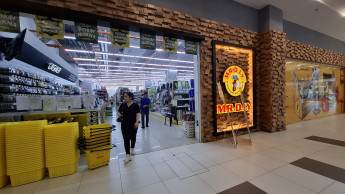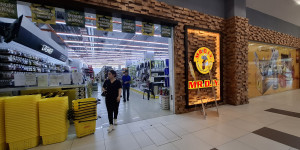The total number of DIY stores belonging to the 30 biggest German DIY retail companies at home and abroad saw an overall increase amounting to 183 (from 3 447 to 3 630) in the period between 31 December 2003 and December 2004
German DIY store groups abroad(.pdf-Datei zum Herunterladen)
The number of outlets in the three “groups of ten” that the list is divided into developed as follows: Growth was evident among the companies listed first in the table (+4.8 per cent; +0.7 per cent in the previous year), though more particularly among the second group (+13.5 per cent; +1.6 per cent). However, the third group recorded a drop of 15.5 per cent (2003: +4.9 per cent). This deficit in the third group can be traced back to the linking up of Nowebau (61 outlets), EGN (36) and Baustoffring (34) to form Celo, a new cooperative organisation. Two of the component companies were previously listed separately, which explains why Leitermann has now moved up onto the bottom of the list. The newly created Celo was responsible for growth in the second group of ten. Further growth in this group was generated by new stores from Hornbach, Hellweg, Max Bahr, Krämer, Globus and Distributa.
New openings by month(.pdf-Datei zum Herunterladen)
Growth through new outlets was not the only criterion for the growth of the stores, even in the case of the Top 10 of the 30 biggest companies. Some growth was achieved by Obi, Hagebau (mainly by means of additional stores in Austria) and EMV-Profi, following a number of additions and subtractions. The enormous growth shown by Zeus is above all the result of bringing the “Werkhaus” outlets into the “Weltmarkt” channel, whose stores over 400 m² in size were included for the first time. What is more, I&M Interbaustoff profited from the merger between Interpares-Mobau and Interbaustoff. In short: The 183 additional outlets claimed by the Top 30 in 2004 can by no means be equated with new openings.
The ten major DIY multiples(.pdf-Datei zum Herunterladen)
If you look back ten years the number of DIY stores belonging to the Top 10 has seen a rise from 1 634 to today’s 2 710, which amounts to an increase of 65.9 per cent. Within the group of the top three companies for the year 2004, Praktiker is the winner of the 10-year expansion stakes at over 112 per cent, ahead of Obi (62.6 per cent) and Hagebau (54.6 per cent). However, most expansionary among the group of the ten biggest companies in 2004 were Baywa, Rewe (Toom/Zack), Zeus and EMV-Profi, which did not even figure among the Top 10 in 1994.
New openings by DIY company
By the end of December 2004 an overall total of 97 new DIY stores (2003: 116) had been opened, 73 of them in Germany. In addition to these came the re-opening of more than 50 stores following major alterations or extensions. More than 80 DIY stores were closed down during this same period.
Contrary to expectation, the number of new openings outside Germany suffered a setback. At any rate, in 2004 only 24.7 per cent (24 stores) of the overall total of new openings were located abroad, which amounts to 12.9 per cent (20 stores) fewer than in 2003. It is not very likely that this setback represents a change in the policy of international expansion. Forward planning by the companies concerned provides for quite a few more stores outside Germany. However, many such plans need time to come to fruition. Upon looking back, it can be seen that the international expansion of the nineties began rather hesitantly. Indeed, in 1994 the German DIY retailers inaugurated only 1.4 per cent of all their new openings beyond the national borders, but two years later that figure had already risen to 10.9 per cent. There was a slight drop to 28.1 per cent in 2002, following on from 30.6 per cent in 2001. Anyone enquiring about the reasons for this international trend will be told above all that it is still possible to achieve high single- and double-figure sales growth in some of the countries of eastern Europe and in Russia, as well as positive contributions to results. On the other hand, the tendency in west European countries outside Germany must be carefully scrutinised, since the inclination to buy is no longer so pronounced there. However, there do still seem to be opportunities for growth in Scandinavia and Switzerland, for instance.
New openings by postcode(.pdf-Datei zum Herunterladen)
New openings by retail area
The 2004 figures are confirmation of the tendency towards ever bigger retail areas that has been evident for some time among the newly opened stores. During the period covered by the review, 42.3 per cent of all the new openings were between 5 000 m² and 10 000 m² in size, whereas in 2003 this share was considerably lower at 31.0 per cent. Also evident was an increase of 1.3 percentage points to 28.9 per cent in the store category in excess of 10 000 m² over the previous year’s figure. The number of new openings over 5 000 m² in size increased by 12.6 per cent compared with 2003 to 71.2 per cent of the total. Which indicates a continuation of the trend towards ever bigger retail areas that suffered an interruption last year.
New opernings by retail area(.pdf-Datei zum Herunterladen)
What is more, the proportion of stores between 2 500 m² and 5 000 m² in size, which has fallen continuously in past years (from 15.1 per cent in 2000 to 10.6 per cent in 2001 and to 9.3 per cent in 2002), with the only exception being the 15.5 per cent recorded in 2003, declined still further in the period under consideration to 8.2 per cent. If all the new outlets over 2 500 m² in size are included in this review, it becomes evident that the percentage attained has increased still further and at a high level over the previous year, since the stores in this category made up 74.1 per cent of all new openings in 2003, whereas the figure was 79.4 per cent in 2004. And at the same time, last year the percentage of all new openings in the category below 1 000 m² in size fell to 8.2 per cent (2003: 16.4 per cent).
If all the stores in the size categories of up to 2 500 m² are added together, a total of 25.9 per cent of all new openings results for this category in 2003, and 20.6 per cent in 2004.
New openings by type of organisation
The DIY multiples landed on the top spot when it came to new openings in 2004, in spite of slight losses over the previous year. But strong increases were notched up by the group in second place, taken by stores belonging to the franchise companies.
New openings ba type of organisation(.pdf-Datei zum Herunterladen)
In detail: In the year under review the DIY multiples accounted for 47.4 per cent of the new openings, whereas the comparable figure for 2003 came to 48.3 per cent. Since the cooperative organisations at 9.3 per cent remained far below the previous year’s figure of 14.6 per cent, the franchise companies were the ones to benefit from this discrepancy. Their share of all new DIY store openings went up by 6.2 per cent, from 37.1 per cent in 2003 to 43.3 per cent in 2004.
Top 30 in German DIY(.pdf-Datei zum Herunterladen)
Germany
Population: 82.5 mioArea: 357 021 km²Rate of inflation 2004: 1.6 %Rate of unemployment 2004: 9.3 %Gross domestic product 2004: E 2 178 bnReal change to GDP 2004: 1.7 %
Source: Federal Bureau of Statistics

 Menü
Menü
















